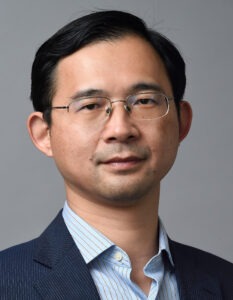This post is part of a series on the Ralph O’Connor Sustainable Energy Institute (ROSEI) website that will feature Q&A’s with our affiliated researchers. Next up is Chao Wang, an associate professor in the Department of Chemical and Biomolecular Engineering who is also a ROSEI core faculty member.
 How did you first get involved with or learn about sustainability?
How did you first get involved with or learn about sustainability?
Chao Wang (CW): When I started my research career, I was doing development of nanomaterials, which are materials that have at least one dimension that is about 100,000 times smaller than the width of a human hair. At that time, we were motivated by trying to control the size, shape, and composition of nanomaterials. Then I began thinking about applications for what we were working on. What sort of problems could we address? I started out by looking at electrolysis in fuel cells, but after joining Hopkins and forming my group, I started learning more about carbon dioxide and climate change. That motivated me to start having my work focus on CO2 reduction. This was the start of my work at Hopkins about CO2 reduction, capture, and what we’re still working on now.
Why are you passionate about sustainability/renewable energy?
CW: Unfortunately, chemical engineers have played a role in our current climate change crisis in the area of fossil fuels. I see that hard truth, so I tell myself and my students that we as chemical engineers can help reverse that, and you can make a career doing it. Chemical engineers used to burn fossil fuels to help create energy, so now our job is to become part of the solution regarding climate change by helping reduce carbon emissions on our planet.
How does your commitment to sustainability play out in your everyday life?
CW: I’m of a little different opinion in terms of how to be sustainable in everyday life. Plastics are a good example. I perform research addressing the plastics problem. In my personal life, though, I am not against using plastics as long as you process the end-of-life plastics properly, like in a recycling bin. My opinion is that no technology is ideal. As an engineer, we are working on improving the technologies that are essential for sustaining our life, instead of going back to the Stone Age. I believe we can do that.
Tell us about your research, and what aspects currently or in the future tie into sustainable energy efforts?
CW: The best way to describe my research is the term “closed-loop economy.” With carbon, we talk about burning fossil fuels, which is still needed for many industry sectors like aviation and ships. However, we can capture carbon back from the air, and then turn it into useful commodities that would close the loop for the anthropologic carbon cycle. This is called “the carbon loop”, but you can do something similar with hydrogen, as well as with metals. This is an important part of sustainability because you need to use all the pieces in the process to achieve it. We are essentially looking to use renewable energy to drive chemical and material “looping” processes, just at the scale of globe and a whole economy.
Is there an article, book, or podcast that you recommend to help people better understand your work and your field in general?
CW: There are a lot of YouTube channels that do a great job of showing the intricacies of my research area. For example, check out the series by OpenAir about direct carbon removal (CDR) from air.
What advice or suggestions do you have for students who want to pursue careers in sustainable energy?
CW: I tell them about the decarbonization of economy and how there is going to be a lot of opportunities to work in that area. It’s already happening, and it is a big field, regardless of whether they are in industry or academia. I encourage my students to align their career goals with decarbonization. One area where this could happen is in the area of carbon credit. Essentially, in the near future everything we buy or sell will have a number printed on the label saying what the carbon footprint for this product is. It is kind of like when you buy food and you can see the ingredients label or “organic”. In the future, companies will do this with carbon to gain tax credits for following environmentally friendly methods. This will be mainstream soon, so I have been encouraging my students to become familiar with the estimation of emission intensity for the processes they are working on.
How has the creation of ROSEI affected sustainable energy efforts at Hopkins?
CW: There are a lot of great things about ROSEI. In my time at Hopkins, I feel that we should have had it way before. Albeit being a new baby, ROSEI is impressive in terms of size, from faculty to students, and will be successful in growing effective sustainable energy research and having an impact on campus and beyond. Of course, we are still in the early stages, so I expect us to grow even further. Something to demonstrate our capabilities as a community, such as translation of technologies, address local community challenges, pursuing a large center grant through ROSEI, come to mind. Those would not be easy, but are targets to aim for.